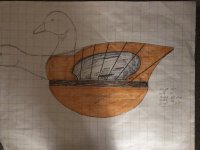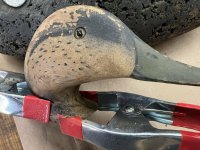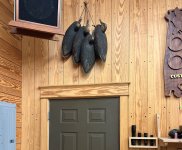Steve Sanford, thank you for sharing your methodologies with us. I continue to learn so much from the contributions on this forum.
You are using an out of date browser. It may not display this or other websites correctly.
You should upgrade or use an alternative browser.
You should upgrade or use an alternative browser.
Workbench - November
- Thread starter MLBob Furia
- Start date
That is a very impressive jointer. Great job on refurbishing of the jointer Eric.
One other project has been cleared from my workbench. I completed the restoration of Jeff's Newman #60 16" jointer. It is the fifth full machine of his I've restored, plus a mechanical restoration. In total I've done a Powermatic 1150 drill press, Powermatic Model 10 mortiser, Powermatic 72 table saw, Powermatic 221 planer, a Tannewitz GH bandsaw (mechanical), and now his Newman No. 60 jointer, all over the past five years since his passing. Jeff was very fond of his machines and wanted to restore all of them himself. He would start but never could finish. These restorations occupied a significant amount of my time, and honestly am very glad to complete them so I can work with them instead of on them. Undone projects stress me and anyone that knows me knows this. I think this may be the best restoration I've done and I'm certain Jeff would be happy with how it turned out. I jointed some wood today and it runs so smooth, and the surface was silky to the touch. Below are some pictures. As of right now it is covered in walnut and oak dust. I've got a lot of projects that will come in contact with this jointer. It will never look this good again but it will run like it is now for many years to come.
Eric
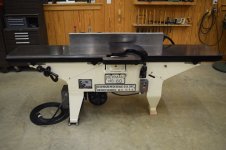
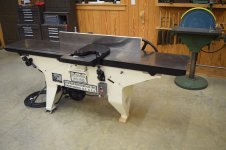
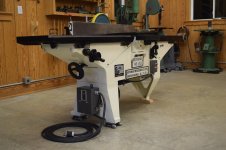
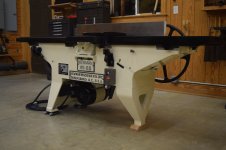
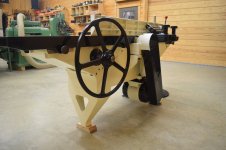
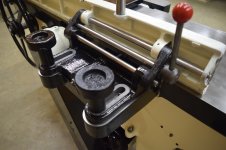
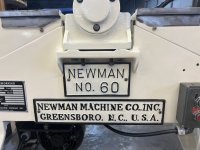
Eric







Last edited:
Thanks Dani. The sheer weight and size of the jointer, even when broken down, made it a challenging project. I was in fear I'd drop and shatter a casting and have to scrap the machine. Luckily that never happened.
Eric
Eric
Nice job on the restoration. You have a talent for it.
Are new blades available for the machine? Or will you sharpen the old ones?
Are new blades available for the machine? Or will you sharpen the old ones?
SJ
They are available. I have two pair. One in the machine and a freshly sharpened set ready to install. The knives can be sharpened many times before they wear to the point of being too small to safely be held in place by the gibs and gib jack screws. I usually pull a set when dull, install the other set, and mail the dull set to a capable sharpener. At 16" long it takes a pretty sophisticated grinding set up to sharpen the edge and have it be .001" of flat. Not something I can do in my shop.
Thank you for the compliment.
Eric
They are available. I have two pair. One in the machine and a freshly sharpened set ready to install. The knives can be sharpened many times before they wear to the point of being too small to safely be held in place by the gibs and gib jack screws. I usually pull a set when dull, install the other set, and mail the dull set to a capable sharpener. At 16" long it takes a pretty sophisticated grinding set up to sharpen the edge and have it be .001" of flat. Not something I can do in my shop.
Thank you for the compliment.
Eric
Last edited:
Matt DeFore
Active member
Thanks
Yeah, its cork
Yeah, its cork
Last edited:
Shopsmith class tonight consisted mainly of replacing the roller bearings in the bandsaw and adjusting the blade guide blocks. It took us an hour to get everything totally set up and adjusted properly. However, I did end up doing some bandsawing. I got to practice with both saws...difference is blade width really. My dads saw was used to cut the bird chunks out of the plywood. I am not super proficient but I have a standalone bandsaw so tonight was mainly just tips on technique and how to approach cutting pieces that can be too long for the throat.
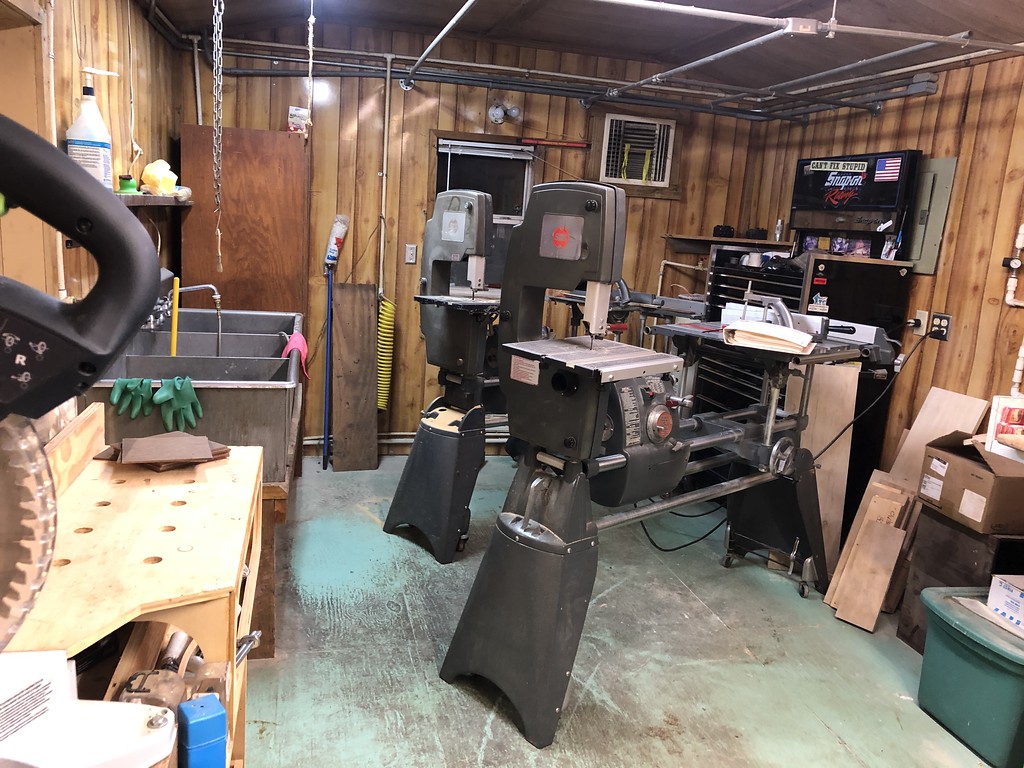
I turned a 1\2" x2'x2' piece of plywood into silhouette decoy chunks. I got two birds cut out before deciding it was time to stop because I was getting tired.
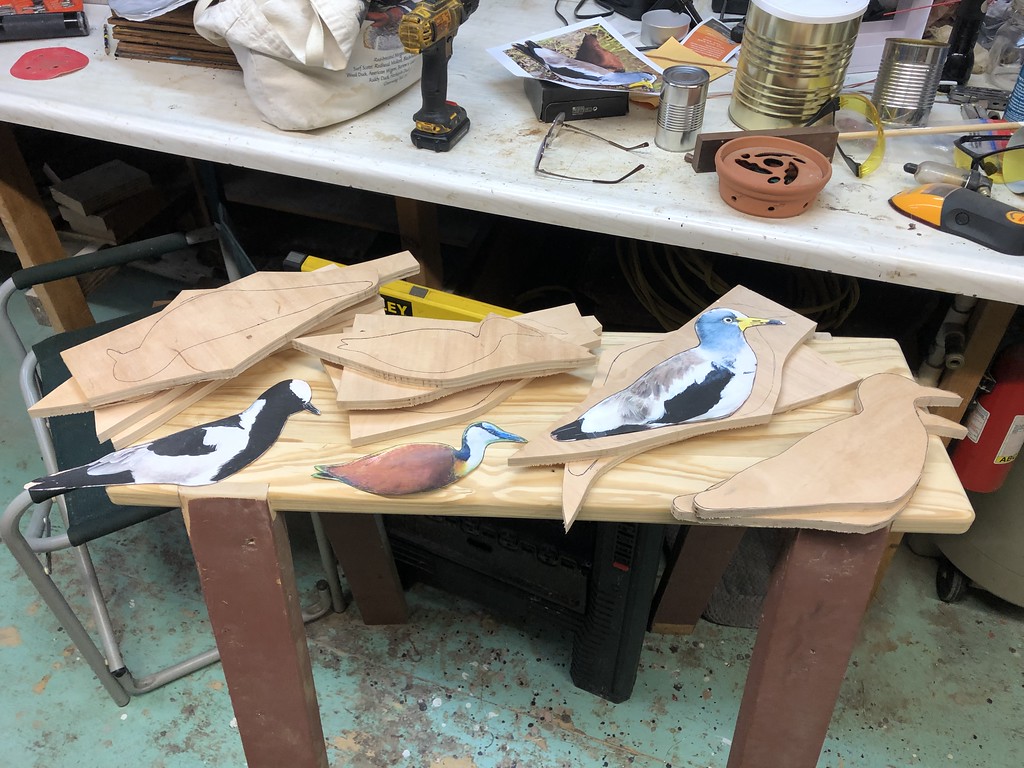
These are three species I saw while I was in Africa. Blacksmith lapwing, african jacana and white crowned lapwing. The white crowned lapwing has a wattle that hangs down from his face. I may use a piece of leather to make the wattle. Any other ideas on material I might use for a wattle?

I turned a 1\2" x2'x2' piece of plywood into silhouette decoy chunks. I got two birds cut out before deciding it was time to stop because I was getting tired.

These are three species I saw while I was in Africa. Blacksmith lapwing, african jacana and white crowned lapwing. The white crowned lapwing has a wattle that hangs down from his face. I may use a piece of leather to make the wattle. Any other ideas on material I might use for a wattle?
Eric Patterson said:Thanks Dani. The sheer weight and size of the jointer, even when broken down, made it a challenging project. I was in fear I'd drop and shatter a casting and have to scrap the machine. Luckily that never happened.
Eric
The parts are brittle?
Dani
That's a great workspace you've set up. I can see many hours of carving enjoyment happening there.
Yes, cast iron is brittle. If you drop a piece, it doesn't dent, it cracks or even worse shatters. Many machines have been rendered useless after being dropped when moving. Castings crack or break into pieces. It doesn't mend very well either. Steel is easily weldable, cast iron isn't. Brazing is possible but isn't terribly strong so a lot of times a cracked casting renders a machine useless and destines it for the scrap yard or to be parted out.
Eric
That's a great workspace you've set up. I can see many hours of carving enjoyment happening there.
Yes, cast iron is brittle. If you drop a piece, it doesn't dent, it cracks or even worse shatters. Many machines have been rendered useless after being dropped when moving. Castings crack or break into pieces. It doesn't mend very well either. Steel is easily weldable, cast iron isn't. Brazing is possible but isn't terribly strong so a lot of times a cracked casting renders a machine useless and destines it for the scrap yard or to be parted out.
Eric
Vince Pagliaroli
Well-known member
Eric,
That's a mighty fine rig of LL BEAN Black Ducks. I agree, "as is" is just right.
Really like how you have them displayed, it also provides a good view of how they will work just fine when put back in action.
A good honest wear decoy has lots of gunning style, and character. I never tire of looking at them.
Best regards
Vince
That's a mighty fine rig of LL BEAN Black Ducks. I agree, "as is" is just right.
Really like how you have them displayed, it also provides a good view of how they will work just fine when put back in action.
A good honest wear decoy has lots of gunning style, and character. I never tire of looking at them.
Best regards
Vince
Al Hansen
Well-known member
Bob that is one dandy looking call you made. I just wanted you to know that I sure miss cutting salt cedar because whenever I ran across a particular tree that contained some decent burls I thought of you. I still use that duck call you made for me.
For years I used to hunt early in the morning on the Rio Grande, then when it was time to go work, I went about cutting at least one or more cords of wood, filled up my truck, then loaded the Mule on the trailer and headed home. Over the years I used to have folks stop their car or truck and come over to ask me one thing. "Why do you cut wood so early in the morning that you would have to use the headlights on the Mule to see?" That is when I told them that I always went duck hunting first, then after hunting, I would go cut wood and bring it home. These were people who had jobs in town so when they would drive by where I always parked my truck they just thought that all I did was cut firewood.
Al
For years I used to hunt early in the morning on the Rio Grande, then when it was time to go work, I went about cutting at least one or more cords of wood, filled up my truck, then loaded the Mule on the trailer and headed home. Over the years I used to have folks stop their car or truck and come over to ask me one thing. "Why do you cut wood so early in the morning that you would have to use the headlights on the Mule to see?" That is when I told them that I always went duck hunting first, then after hunting, I would go cut wood and bring it home. These were people who had jobs in town so when they would drive by where I always parked my truck they just thought that all I did was cut firewood.
Al


